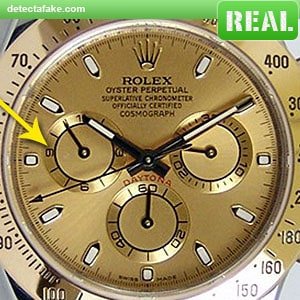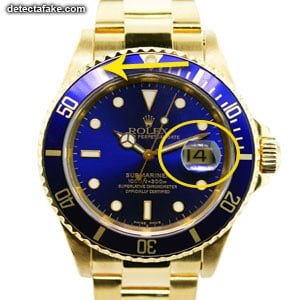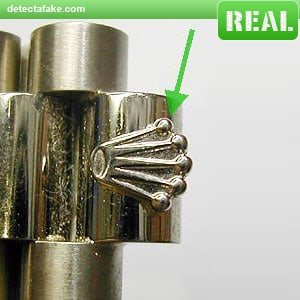How to detect fake Rolex Watches
| Step | Aspect to Check | Genuine Rolex | Fake Rolex |
|---|---|---|---|
| 1 | Box and Certificate | Perfect spelling and alignment | Potential spelling errors and low-quality printing |
| 2 | Face Letters and Numbers | Crisp, clear, and sharp | Bleeding, fuzziness, and misalignment |
| 3 | Chronograph Numbers | No 20, 30, 40 | Presence of 20, 30, 40 |
| 4 | Crown Ball Points | Spherical and 3D | Irregular shape |
| 5 | Inscribed “Rolex” | Engraved with laser | Printed in ink |
| 6 | Engraved Crown | Visible with loupe, not straight on | Absence or visible straight on |
| 7 | Lug and Crystal | Vertical crown, greenish tint | Misaligned crown, different crystal tint |
| 8 | Day Display | Almost fills cyclops lens | Takes up only half the window |
| 9 | Bezel Movement | Only counter-clockwise | Moves in both directions |
| 10 | Second Hand Motion | 8 steps per second | One-second steps |
| 11 | Clasp with Rolex Crown | Present | Absent |
| 12 | Clasp Stamp | Clean and crisp, stamped “750” or “18KT” | Unclear stamps or different markings |
| 13 | Movement Stamp | Visible, stamped with Rolex name | Hidden or not stamped |
| 14 | Water Surface Tension | Pulls together on sapphire | Spreads out on non-sapphire crystals |
How to detect fake Rolex Watches: Ever wondered if your prized Rolex watch is the real deal or a convincing impostor? With the influx of replica Rolex watches flooding the market, it’s crucial to distinguish between authenticity and imitation. In this guide, we’ll walk you through key steps to authenticate your Rolex and ensure your investment is as genuine as the craftsmanship it represents.
Decoding Authenticity: A Step-by-Step Guide
Step 1: Box and Certificate


Begin your quest for authenticity by scrutinizing the box and certificate. Authentic Rolex packaging boasts perfect spelling and alignment, setting the stage for genuine craftsmanship.
Step 2: Face Letters and Numbers


Dive into the details with a jeweler’s loupe or magnifying glass. Genuine Rolex watches exhibit crisp, clear letters and numbers with sharp corners, leaving no room for bleeding or fuzziness.
Step 3: Chronograph Numbers


If your Rolex is a “Daytona,” pay close attention to the chronograph numbers. A telltale sign of a fake is the presence of 20, 30, and 40, as authentic Rolex chronographs never feature these digits.
Step 4: Crown Ball Points


Inspect the crown, where genuine Rolex ball points showcase a spherical and 3D effect. Anything less than perfection may indicate a counterfeit.
Step 5: Inscribed “Rolex”


Turn your gaze to the inner rim of the dial, where an authentic Rolex engraves the word “Rolex” with high-resolution laser precision, standing out from the ink-printed imitation.
Step 6: Engraved Crown


Unveil authenticity with a jeweler’s loupe, revealing the etched crown at the crystal’s bottom. A genuine Rolex keeps this crown discreet, visible only under magnification.
Step 7: Lug and Crystal


Ensure the lug holds the crown vertically, accompanied by a slight greenish tint on the crystal – a signature of Rolex’s sapphire crystals.
Step 8: Day Display and Bezel Movement


Verify the day display’s magnification and the bezel’s unidirectional movement. Authentic Rolex watches boast 2.5x magnification and only move counter-clockwise.
Step 9: Second Hand Motion

Watch the second hand dance – a genuine Rolex moves smoothly in 8 steps per second, creating a continuous, mesmerizing motion.
Step 10: Clasp with Rolex Crown


Authenticate your clasp by confirming the presence of the iconic Rolex crown, a hallmark of genuine craftsmanship.
Step 11: Clasp Stamp


Inspect the clasp’s interior for a clean stamp, either “750” or “18KT,” ensuring authenticity and precious metal content.
Step 12: Movement Stamp

For thorough verification, ask the dealer to reveal the movement stamp. Genuine Rolex watches proudly display their name, a crucial detail that counterfeiters often omit.
Step 13: Water Surface Tension

Conclude your authenticity check with a water test. Genuine Rolex crystals, made from sapphire, resist water spread, maintaining a smooth surface tension.
Ex:- Consider a real-world scenario: a water drop on a sapphire crystal, showcasing the immediate cohesion, proving its genuine quality.
Frequently Asked Questions
1. How can I authenticate a Rolex without a jeweler’s loupe?
You can still perform a basic authenticity check by focusing on visible details like printing quality, magnification, and movement.
2. Are there specific Rolex models more prone to counterfeiting?
While counterfeiters target popular models, it’s essential to authenticate any Rolex thoroughly, regardless of the model.
3. Can I trust a dealer who refuses to show the movement stamp?
A reputable dealer should have no qualms about revealing the movement stamp. Be cautious if transparency is lacking.
4. Do all genuine Rolex watches have a water-resistant feature?
Yes, authentic Rolex watches are designed to be water-resistant. However, specific models may have different levels of water resistance.
5. Is a misaligned crown a definitive sign of a fake Rolex?
While it’s a red flag, it’s crucial to consider multiple aspects for a comprehensive authenticity assessment.
Conclusion
Armed with these detailed steps, you can confidently navigate the world of Rolex watches, ensuring your investment reflects the unparalleled craftsmanship synonymous with the brand. Don’t just wear a Rolex; wear the authenticity that comes with it.
